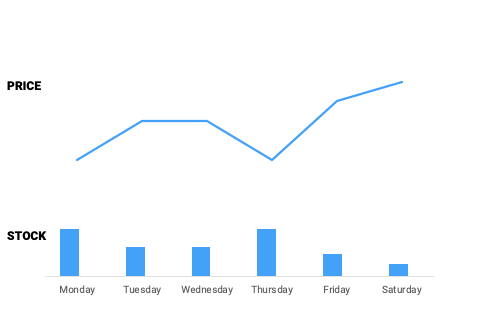Last week, as a response to the coronavirus, we offered some pricing advice to our customers: use stock levels as a way to prevent unintentional price drops on your products.
To give some more background on this pricing method, we decided to create a blog post outlining what stock-based pricing is, why you may want to use this pricing method, and a few different strategies to consider while implementing it. Keep reading to learn more about this versatile pricing method and how you can use it strategically.
What is stock-based pricing?
Stock-based pricing is a pricing method. With this method, you can choose to use stock as a factor for a product’s price.
In the graphic below you can see stock-based pricing at work in its most traditional setting. On Monday, when stock levels were high (as indicated by the blue bar), the price for this product (indicated by the blue line) was somewhat low.

By Tuesday and Wednesday though, the stock levels dropped, and the price increased as a result. By restock on Thursday the price decreased again. As stock numbers dipped on Friday and Saturday, the price increased once again.
Why use stock-based pricing?
Stock-based pricing combines well with other pricing methods, and is a great way to enhance your overall pricing strategy. It also gives you some more control over what happens in your store as stock levels change. Even if used alone, stock-based pricing will help protect margins and can make your store more competitive.
When you make a pricing rule, instead of making rules on actual stock levels, you want to set rules on stock coverage and stock age.
Stock coverage is stock level divided by sell through. It's a more insightful metric because stock levels mean very little without relating to sell through. In Omnia, the field to use for the sell through is units sold in the last four weeks. Stock age is the number of days since the last stock increase or resupply.
If you don't use both of these metrics, your dynamic pricing tool may begin to immediately discount on new products. At the start, the stock may be high, but the sell-through may be zero.
Examples of stock-based pricing strategies
Stock-based pricing can work into many different kinds of strategies. In some ways it should be an element of any well-rounded pricing strategy. If you’re just getting started though, there are four simple ways to use stock based pricing in a dynamic pricing tool.
When you have high stock levels: use your standard pricing strategy
This strategy is a “business as usual” strategy. When you implement this rule in your dynamic pricing tool, the tool will follow your standard pricing strategy as long as stock levels remain high.
When you have high stock levels: decrease your prices
Do you have some unwanted inventory that you’d like to get rid of? This is a great chance to use stock levels as a trigger to decrease the price. This strategy can be used any time of year if you have overstock, or simply just want to pursue an aggressive pricing strategy.
When you have low stock levels: increase your prices
In most cases, it is perfectly acceptable to increase your product price if there is a limited supply in stock. The main reason to do this is to prevent running out of stock too quickly on high-runners. This is especially useful during the coronavirus pandemic when global supply chains are unstable.
This strategy also follows the basic law of supply and demand, and is something consumers understand inherently. That said, it might be worth packaging this strategy around a limited-edition product that has extra, more expensive features.
When you have low stock levels: decrease price
The final basic stock-based strategy is to lower your price when your stock levels decrease. This may sound counterintuitive, but if there is product that you want to clear out, this may be a strategy to consider.
This strategy is great for end-of-season sales or holiday-themed products, for example.
Advanced stock-based pricing
The above scenarios are only the beginning of what you can do with stock-based pricing. Below are two more “advanced” pricing methods.
Use seasonality
When it comes to seasonal products, low stock may not be a good trigger to increase prices. In the case of these products like winter jackets, outdoor sports equipment, home repair supplies, and more, the response to stock levels will vary by the calendar month.
Say you’re selling winter coats. If your stock is low in November, it might be a great trigger for a price increase. But if your stock is low in April or May and your price increases, you risk missing out on sales or damaging your price perception.
If you are selling seasonal goods, you can have your dynamic pricing system automatically check if your stock rotates at a healthy pace. Is your stock rotating too slow? The system will slightly decrease prices. Are you selling too fast? The system can slightly raise prices to add some extra margin. By using this strategy, you maximize your bottom line margin on a SKU level and prevent going into the end of season sales.
Do you need to update the seasonality of these products every few months? Not necessarily. Your dynamic pricing tool may have seasonality embedded into its pricing rules. In Omnia, you can provide the end of season date in your feed and the tool will automatically factor this into its price advices.
Add sales data
Combining stock-based pricing with sales data from the previous week (or month) can be useful for planning your pricing and stock strategy.
If you see that sales are consistently higher on Mondays, for example, you can adjust your prices and stock levels on that day according to your commercial strategy.
If your goal is to be a premium retailer with small-batch orders, you may limit your stock on Monday and increase your prices accordingly. If you want to follow a more aggressive pricing strategy, you may increase your stock for the Monday flow and decrease your prices.
Final thoughts
Stock-based pricing is a great supplement to any existing pricing strategy. During the coronavirus outbreak as the market becomes more dynamic, it’s especially useful to protect the stock levels of your high-runner products and prevent unintentional shortages in supply.





